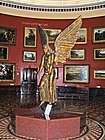art.wikisort.org - Artist
Sir Jacob Epstein KBE (10 November 1880 – 21 August 1959) was an American-British sculptor who helped pioneer modern sculpture.[1][2][3][4] He was born in the United States, and moved to Europe in 1902, becoming a British subject in 1911.
Sir Jacob Epstein KBE | |
|---|---|
 Jacob Epstein, photographed in 1921 by George Charles Beresford | |
| Born | 10 November 1880 New York City, U.S. |
| Died | 21 August 1959 (aged 78) Kensington, London, England |
| Nationality | British / United States |
| Alma mater |
|
| Known for | Sculpture |
| Spouses |
|
| Children | 5, including Theodore and Kathleen |
He often produced controversial works which challenged ideas on what was appropriate subject matter for public artworks. He also made paintings and drawings, and often exhibited his work.[5]
Early life and education
Epstein's parents, Max and Mary Epstein,[6] were Polish Jewish refugees,[7][8] living on New York's Lower East Side. His family was middle-class, and he was the third of five children. His interest in drawing came from long periods of illness; as a child he suffered from pleurisy.
He studied art in his native New York as a teenager, sketching the city, and joined the Art Students League of New York in 1900. For his livelihood, he worked in a bronze foundry by day, studying drawing and sculptural modelling at night. Epstein's first major commission was to illustrate Hutchins Hapgood's 1902 book The Spirit of the Ghetto. Epstein used the money from the commission to move to Paris.
Move to Europe
Moving to Europe in 1902, he studied in Paris at the Académie Julian and the École des Beaux-Arts. He settled in London in 1905 and married Margaret Dunlop in 1906.[9] Epstein became a British subject on 4 January 1911.[10] Two other sources claim 1907.[45], [46].[11]
Many of Epstein's works were sculpted at his two cottages in Loughton, Essex, where he lived first at number 49 then 50, Baldwin's Hill (there is a blue plaque on number 50). During World War I he served briefly in the 38th Battalion of the Royal Fusiliers, known as the Jewish Legion; following a breakdown, he was discharged in 1918 without having left England.
Work


In London, Epstein involved himself with a bohemian and artistic crowd. Revolting against ornate, pretty art, he made bold, often harsh and massive forms of bronze or stone. His sculpture is distinguished by its vigorous rough-hewn realism. Avant-garde in concept and style, his works often shocked his audience. This was not only a result of their (often explicit) sexual content, but also because they deliberately abandoned the conventions of classical Greek sculpture favoured by European academic sculptors, to experiment instead with the aesthetics of art traditions as diverse as those of India, China, ancient Greece, West Africa, and the Pacific Islands.[12][13] People in Liverpool nicknamed his nude male sculpture over the door of Lewis's department store (1954–56) "Dickie Lewis". Such factors may have focused disproportionate attention on certain aspects of Epstein's long and productive career, throughout which he aroused hostility, especially challenging taboos surrounding the depiction of sexuality.
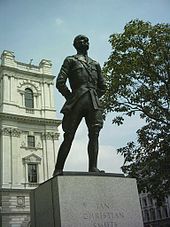
London was not ready for Epstein's first major commission – 18 large nude sculptures made in 1908 for the façade of Charles Holden's building for the British Medical Association on The Strand (now Zimbabwe House) were initially considered shocking to Edwardian sensibilities, again mainly due to the perception that they were sexually over-explicit. In art-historical terms, however, the Strand sculptures were controversial for quite a different reason: they represented Epstein's first thoroughgoing attempt to break away from traditional European iconography in favour of elements derived from an alternative sculptural milieu – that of classical India. The female figures in particular may be seen deliberately to incorporate in no uncertain terms the posture and hand gestures of Buddhist, Jain and Hindu art from the subcontinent.[14][15] The current, mutilated condition of many of the sculptures is also not entirely connected with prudish censorship; the damage was caused in the 1930s when possibly dangerous projecting features were hacked off after pieces fell from one of the statues.
One of the most famous of Epstein's early commissions is Oscar Wilde's tomb in Père Lachaise Cemetery, Paris, "which was condemned as indecent and at one point was covered in tarpaulin by the French police."[16]

Between 1913 and 1915, Epstein was associated with the short-lived Vorticism movement and produced one of his best known sculptures The Rock Drill.
In 1915, John Quinn, wealthy American collector and patron to the modernists, bought some Epstein sculptures to add to his private collection.[17]

In 1916, Epstein was commissioned by Viscount Tredegar to produce a bronze head of Newport poet W. H. Davies. The bronze, regarded by many as the most accurate artistic impression of Davies and a copy of which Davies owned himself, may be found at Newport Museum and Art Gallery[18]
In 1928, Epstein sculpted the head of the popular singer and film star Paul Robeson. A commission from Holden for the new headquarters building of the London Electric Railway generated another controversy in 1929. His nude sculptures Day and Night above the entrances of 55 Broadway were again considered indecent and a debate raged for some time regarding demands to remove the offending statues which had been carved in-situ. Eventually a compromise was reached to modify the smaller of the two figures represented on Day. But the controversy affected his commissions for public work which dried up until World War II.

Between the late 1930s and the mid-1950s, numerous works by Epstein were exhibited in Blackpool. Adam, Consummatum Est, Jacob and the Angel and Genesis, and other works, were initially displayed in an old drapery shop surrounded by red velvet curtains. The crowds were ushered in at the cost of a shilling by a barker on the street. After a small tour of American fun fairs, the works were returned to Blackpool and were exhibited in the anatomical curiosities section of Louis Tussaud's waxworks. The works were displayed alongside dancing marionettes, diseased body parts and conjoined ("Siamese") twin babies in jars. Placing Epstein within the context of freakish curiosity perhaps added to Epstein's decision not to create further large-scale direct carvings.

Bronze portrait sculpture formed one of Epstein's staple products, and perhaps the best known. These sculptures were often executed with roughly textured surfaces, expressively manipulating small surface planes and facial details. Some fine examples are in the National Portrait Gallery. Another example is the bust of the Arsenal manager Herbert Chapman that sat in the marble halls of Highbury for many years before being moved to the new Emirates Stadium.
During the Second World War, Epstein was asked to undertake six commissions for the War Artists' Advisory Committee. After completing bronze busts of Admiral of the Fleet Sir Andrew Cunningham, General Sir Alan Cunningham, and Air Marshal Sir Charles Portal - and Ernest Bevin, Epstein accepted a commission to create busts of John Anderson and Winston Churchill. He completed a bust of Winston Churchill in early 1947.
Epstein's aluminium figure of Christ in Majesty (1954–55), is suspended above the nave in Llandaff Cathedral, Cardiff, on a concrete arch designed by George Pace.
His larger sculptures were his most expressive and experimental, but also his most vulnerable. His depiction of Rima, one of author W. H. Hudson's most famous characters, graces a serene enclosure in Hyde Park. Even here, a visitor became so outraged as to defile it with paint. He was one of 250 sculptors who exhibited in the 3rd Sculpture International, which was organised by the Fairmount Park Association (now the Association for Public Art) and held at the Philadelphia Museum of Art in the summer of 1949.
Epstein would often sculpt the images of friends, casual acquaintances, and even people dragged from the street into his studio almost at random. He worked even on his dying day. He also painted; many of his watercolours and gouaches were of Epping Forest, where he lived (at Loughton) and sculpted. These were often exhibited at the Leicester Galleries in London. His Monkwood Autumn and Pool, Epping Forest date from 1944 to 1945.
Epstein was Jewish,[19][20][21][22] and negative reviews of his work sometimes took on an antisemitic flavour, though he did not attribute the "average unfavorable criticism" of his work to antisemitism.[23]
Epstein met Albert Einstein at Roughton Heath, Norfolk, in 1933 and had three sittings for a bust. He remembered his meeting with Einstein as, "His glance contained a mixture of the humane, the humorous and the profound. This was a combination which delighted me. He resembled the ageing Rembrandt."[24]
Personal life
![Kathleen [Garman], 1935, Bristol City Museum and Art Gallery, donated by Lawrence Ogilvie in the 1980s](http://upload.wikimedia.org/wikipedia/commons/thumb/5/5e/Kathlene_by_Jacob_Epstein.jpg/220px-Kathlene_by_Jacob_Epstein.jpg)
Despite being married to and continuing to live with Margaret, Epstein had a number of relationships with other women that brought him his five children: Peggy Jean (1918–2010), Theo (1924–1954), Kathleen (1926–2011), Esther (1929–1954) and Jackie (1934–2009).[25] Margaret generally tolerated these relationships – even to the extent of bringing up his first and last children. In 1921, Epstein began the longest of these relationships, with Kathleen Garman, one of the Garman sisters,[26] mother of his three middle children, which continued until his death. Margaret "tolerated Epstein's infidelities, allowed his models and lovers to live in the family home and raised Epstein's first child, Peggy Jean, who was the daughter of Meum Lindsell, one of Epstein's previous lovers, and his last, Jackie, whose mother was the painter Isabel Nicholas.[27] Evidently, Margaret's tolerance did not extend to Epstein's relationship with Kathleen Garman, as in 1923 Margaret shot and wounded Kathleen in the shoulder."[16]
Margaret Epstein died in 1947, and after Epstein was appointed a Knight Commander of the Order of the British Empire in the 1954 New Year Honours,[28] he married Kathleen Garman in 1955.
Their eldest daughter, also named Kathleen but known as "Kitty", married painter Lucian Freud in 1948 and was mother of his daughters Annie and Annabel. She is the subject of the painting Portrait of Kitty. In 1953 they divorced. She married a second time in 1955, to economist Wynne Godley.[29] They have one daughter.[29]
Death and legacy
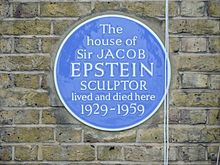
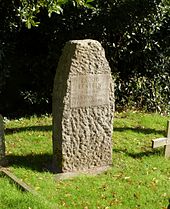
Epstein died in August 1959 in Kensington[3][30] and is interred in Putney Vale Cemetery.
A blue plaque is found at "Deerhurst", 50 Baldwins Hill in Loughton, Epstein's home from 1933 to 1950.[31]
The Garman Ryan Collection, including several works by Epstein, was donated in 1973 to the people of Walsall by Lady Epstein. It is on display at The New Art Gallery Walsall.[32]
Epstein's art is to be found all over the world. Highly original for its time, it substantially influenced the younger generation of sculptors such as Henry Moore[33][34] and Barbara Hepworth.[35] According to June Rose's biography, during the early 1920s Moore visited Epstein in his studio and was befriended by the older sculptor. Epstein, Moore, and Hepworth all expressed deep fascination with non-western art in the British Museum.
In March 2000 the Epstein Estate appointed Tate Images as Copyright Agent for all permissions clearance.
Selected major pieces
- 1907–08 Ages of Man, British Medical Association headquarters, Strand, London – mutilated/destroyed
- 1910 Rom, limestone, Portrait of Romily Epstein, Welsh National Museum of Art, Cardiff, Wales.[36]
- 1911–12 Oscar Wilde Memorial – Père Lachaise Cemetery, Paris
- 1913–14 The Rock Drill, bronze[37] — the Tate Collection (symbolising 'the terrible Frankenstein's monster we have made ourselves into')
- 1917 Venus marble – Yale University Art Gallery, New Haven, Connecticut
- 1919 Christ Bronze – Wheathampstead, England
- 1921 Bust of Jacob Kramer - Leeds Art Gallery, Leeds
- 1922–30 Head of Hans Kindler - Kemper Art Museum, St. Louis, MO
- 1924–25 W. H. Hudson Memorial, Rima, Hyde Park, London
- 1926 Bronze bust of Ramsey MacDonald, Palace of Westminster, London[38]
- 1928–29 Night and Day Portland Stone – 55 Broadway, St. James', London
- 1933 Head of Albert Einstein Bronze – Honolulu Museum of Art
- 1939 Adam Alabaster – Blackpool, England; now at Harewood House, near Leeds
- 1940–41 Jacob and the Angel Alabaster[39] – the Tate Collection (originally controversially "anatomical")
- 1944– 45 The Archangel Lucifer - Bronze - Birmingham Museum and Art Gallery[40]
- 1947–48 Lazarus Hoptonwood Stone – Now in chapel of New College, Oxford
- 1950 Madonna and Child Bronze, Convent of the Holy Child Jesus, London
- 1954 Social Consciousness[41] – University of Pennsylvania, Philadelphia[42]
- 1954–55 Christ in Majesty – Aluminium – Llandaff Cathedral, Cardiff
- 1956 Liverpool Resurgent[43] – Lewis's Building, Liverpool
- 1957 Bust of William Blake, Westminster Abbey, London[44]
- 1958 St Michael's Victory over the Devil Bronze – Coventry Cathedral
- 1959 The Rush of Green (also known as Pan or The Bowater House Group), Hyde Park, London
Sculptures
- Oscar Wilde's tomb, 1912, Père Lachaise Cemetery, Paris
- Lilian Shelly, bronze, 1920, Burrell Collection, Glasgow, UK
- Hudson Memorial Bird Sanctuary, 1924, Hyde Park, London
- The Visitation, 1926, Queensland Art Gallery
- Day and Night, Portland stone, 1928, London Electric Railway headquarters, 55 Broadway[note 2]
- The Archangel Lucifer, 1944–45, round gallery of Birmingham Museum & Art Gallery
- Liverpool Resurgent, 1956, Lewis's store, Liverpool
- Edward Sydney Woods, 1958, Lichfield Cathedral
- Pan Statue, also known as Rush of Green, 1961, by Edinburgh Gate, south side of Hyde Park, London
Bibliography
- Epstein, Jacob, The sculptor speaks: Jacob Epstein to Arnold L. Haskell, a series of conversations on art (London: W. Heinemann, 1931)
- Epstein, Jacob, Let there be sculpture: an autobiography (London: Michael Joseph, 1940)
Notes
- Epstein, wrote Conrad, "has produced a wonderful piece of work of a somewhat monumental dignity, and yet—everybody agrees—the likeness is striking." Zdzisław Najder, Joseph Conrad: A Life, Camden House, 2007, ISBN 978-1-57113-347-2, p. 568.
- When unveiled, the sculptures were considered too shocking.
References
- Epstein, Sir Jacob. The Houghton Mifflin Dictionary of Biography, p. 498. Houghton Mifflin Harcourt, 2003. ISBN 978-0-618-25210-7
- "Epstein, Jacob" entry in Academic American Encyclopedia, vol. 10, p. 223. Grolier Incorporated, 1994. ISBN 0-7172-2053-2
- Encyclopædia Britannica. Sir Jacob Epstein (British sculptor)
- " Epstein, Jacob" entry in Futurism & Futurisms, p. 472. Abbeville Press, 1986. ISBN 0-89659-675-3
- Carrick Hill, Jacob Epstein Archived 12 February 2014 at the Wayback Machine
- UK, Naturalisation Certificates and Declarations, 1870-1916
- Jewish Virtual Library. Sir Jacob Epstein (1880–1959)
- Schreiber, Mordecai; Schiff, Alvin I.; Klenicki, Leon. The Shengold Jewish Encyclopedia, p. 33. Schreiber Pub., 2003. ISBN 978-1-887563-77-2
- "Index entry". FreeBMD. ONS. Retrieved 18 February 2018.
- "No. 28462". The London Gazette. 3 February 1911. p. 874.
- tate.org.uk, 2021defining moments in art, pg 86,isbn-13:978-1-84403-587-8, 2008
- Arrowsmith, Rupert Richard. Modernism and the Museum: Asian, African and Pacific Art and the London Avant Garde. Oxford University Press, 2011, pp.103–164.
- "A&A | Jacob Epstein: Sculptor in Revolt: Sculptor in Revolt". www.artandarchitecture.org.uk. Retrieved 16 June 2020.
- "Jacob Epstein – the Indian connection", The Burlington Magazine, November 2008.
- Video of a Lecture detailing Epstein's Debts to Indian Temple Sculpture, London University School of Advanced Study, March 2012. For another perception on these sculptures and on Indian influence on Epstein, see: Gilboa, "Unto Heaven will I ascend", pp.124-5.
- "Jacob Epstein". Archived from the original on 19 October 2008.
- Stock, Noel (1970). The Life of Ezra Pound. Pantheon Books. p. 202
- "'William Henry Davies' by Jacob Epstein, January 1917". Retrieved 9 November 2017.[permanent dead link]
- "ART: Familiar Sensation", TIME, 25 March 1935. "The spectacle to which he referred was an 11-ft., 7-ton statue of Christ propped against the wall in London's swank Leicester Galleries, the latest work of a heavyset, U.S.-born Jewish sculptor, Jacob Epstein."
- Ezra Mendelsohn, Painting a People: Maurycy Gottlieb and Jewish Art, University Press of New England, 2002, p. 240. "In his discussion of the American-born Jewish sculptor Jacob Epstein, Hutchins Hapgood writes"
- Alyson Pendlebury, Portraying 'the Jew' in First World War Britain, Vallentine Mitchell, 2006, p. 165. "Among the most striking of these is an image of the Anglo-Jewish sculptor Jacob Epstein, a private in the 38th battalion, modelling a human figure out of sand"
- Peter Lawson, Anthony Rudolf, Anglo-Jewish Poetry from Isaac Rosenberg to Elaine Feinstein, Vallentine Mitchell, 2006, p. 84. "with the American-Jewish sculptor Jacob Epstein"
- Epstein, Jacob. Let There Be Sculpture, READ Books, 2007, p. 180. ISBN 978-1-4067-2981-8
- Ronald W. Clark, Einstein: The Life and Times, London: Avon Publishing, 2001, p.603 ISBN 978-0-380-01159-9
- "Jackie Epstein".
- Three sisters with a love, and lust, for life Archived 20 October 2013 at the Wayback Machine, Camden New Journal, 9 September 2004. Retrieved 23 August 2010
- Jacobi, Carol (18 February 2021). Out of the Cage: The Art of Isabel Rawsthorne. London: The Estate of Francis Bacon Publishing. p. 53. ISBN 978-0-500-97105-5.
- "No. 40053". The London Gazette (Supplement). 29 December 1953. p. 10.
- Connolly, Cressida (19 January 2011). "Kitty Godley obituary". The Guardian. Retrieved 22 March 2013.
- "Index entry". FreeBMD. ONS. Retrieved 18 February 2018.
- Loughton Town Council: Blue Heritage Plaques at loughton-tc.gov.uk Archived 27 August 2008 at the Wayback Machine
- "Collections Archive - The New Art Gallery Walsall".
- Berthoud, Roger, The Life of Henry Moore, A William Abrahams Book, E.P. Dutton, New York 1987
- Read, Herbert, Henry Moore: A study of his life and work Frederick A. Praeger, Publishers, New York, 1966
- Hammacher, A.M., The Sculpture of Barbara Hepworth, Harry H. Abrams, Inc., New York 1968
- Fairclough 2011, p. 126.
- "The story of Jacob Epstein's 'Rock Drill' | Tate". Archived from the original on 23 January 2018. Retrieved 9 November 2017.
- Malcolm Hay & Jacqueline Riding (1996). Art in Parliament - The Permanent Collection of the House of Commons. Jarrod Publishing & The Palace of Westminster. ISBN 0 7117 0898 3.
- http://www.tate.org.uk/art/images/work/T/T07/T07139_10.jpg [bare URL image file]
- "The Archangel Lucifer By Jacob Epstein".
- "Pintando con luz - Social Consciousness". titilos.sorocabana.com. Archived from the original on 24 May 2007.
- "Two monumental sculptures arrive on campus". Penn Today. Retrieved 11 October 2019.
- "News: Liverpool News - Liverpool Echo".
- "William Blake". Westminster Abbey. Retrieved 5 November 2022.
- Fairclough, Oliver (2011). A Companion Guide to the Welsh National Museum of Art. Cardiff: National Museum Wales Books. ISBN 978-0-72-000613-1.
Further reading
Below is a brief overview of key texts relating to Epstein:
- Buckle, Richard, Jacob Epstein: sculptor (London: Faber 1963)
- Cork, Richard, Jacob Epstein (London: Tate Gallery Publishing, 1999)
- Cronshaw, Jonathan, Carving a Legacy: The Identity of Jacob Epstein (PhD Thesis, University of Leeds, 2010)
- Cronshaw, Jonathan, "this work was never commissioned at all": Jacob Epstein's Madonna and Child (1950–52), Art and Christianity 66, Summer 2011
- Friedman, Terry, 'The Hyde Park atrocity': Epstein's Rima: creation and controversy (Leeds: Henry Moore Centre for the Study of Sculpture, 1988)
- Gardner, Stephen, Jacob Epstein: Artist Against the Establishment (London: Joseph, 1992)
- Gilboa Raquel, ...And There Was Sculpture; Epstein's Formative Years (1880–1930) (London, 2009)
- Gilboa Raquel, ...Unto heaven will I ascend; Jacob Epstein's Inspired Years (1930–1959) (London, 2013)
- Gilboa Raquel, Epstein and 'Adam' Revisited, The British Art Journal, Winter 2004, 73–79
- Gilboa Raquel, Jacob Epstein's model Meum: Unpublished drawings, The Burlington Magazine, CXVII, 837–380
- Hapgood, Hutchins, The spirit of the ghetto: studies of the Jewish quarter of New York; with drawings from life by Jacob Epstein (New York; London: Funk and Wagnalls, 1909)
- Silber, Evelyn, et al. Jacob Epstein: sculpture and drawings, (Leeds: Leeds City Art Galleries; London: Whitechapel Art Gallery, 1987)
- Silber, Evelyn, The Sculpture of Epstein (London, 1984)
- Colin Turner, A Caricature of a Sculptor. Jacob Epstein and the British Press: a critical analysis of old history and new evidence (PhD Thesis, Loughborough University, 2009)
- Carving mountains: modern stone sculptures in England 1907–37: Frank Dobson, Jacob Epstein, Henri Gaudier-Brzeska, Eric Gill, Barbara Hepworth, Henry Moore, Ben Nicholson, John Skeaping (Cambridge: Kettles Yard, 1998)
- Embracing the Exotic: Jacob Epstein & Dora Gordine (Ben Uri Gallery and Museum, 2006)
External links
- 319 artworks by or after Jacob Epstein at the Art UK site
- 9 artworks by Jacob Epstei at the Ben Uri site
- Jacob Epstein An article on Jacob Epstein's work on The National Archives website. Includes references to files held at The National Archives.
- Jon Cronshaw, Einstein captured in bronze as he fled
- Londonist.com – Jacob Epstein in London
- Jacob Epstein: Sculptor in Revolt (art and architecture)
- Works by Jacob Epstein at Project Gutenberg
- Works by or about Jacob Epstein at Internet Archive
На других языках
[de] Jacob Epstein
Sir Jacob Epstein KBE (* 10. November 1880 in New York; † 19. August 1959 in London) war ein amerikanisch-britischer Bildhauer und Zeichner.- [en] Jacob Epstein
[es] Jacob Epstein
Jacob Epstein (Nueva York, 10 de noviembre de 1880-Kensington, Inglaterra; 19 de agosto de 1959) fue un escultor nacido en Estados Unidos, que trabajó principalmente en Inglaterra.[fr] Jacob Epstein
Jacob Epstein (10 novembre 1880 – 19 août 1959) est un sculpteur américain qui a surtout travaillé en Angleterre. Il fut un pionnier de la sculpture moderne, dont les œuvres souvent controversées repoussaient les limites de ce que l'art pouvait montrer.[it] Jacob Epstein
Sir Jacob Epstein (New York, 10 novembre 1880 – Londra, 19 agosto 1959) è stato uno scultore e pittore statunitense naturalizzato inglese.[ru] Эпстайн, Джейкоб
Сэр Дже́йкоб Э́пстайн[6] (англ. Jacob Epstein; 10 ноября 1880, Нью-Йорк — 19 августа 1959, Лондон) — английский и американский скульптор и график, один из пионеров скульптуры стиля модерн.Другой контент может иметь иную лицензию. Перед использованием материалов сайта WikiSort.org внимательно изучите правила лицензирования конкретных элементов наполнения сайта.
WikiSort.org - проект по пересортировке и дополнению контента Википедии

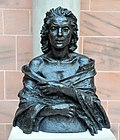
![Joseph Conrad, 1924, National Portrait Gallery, London[note 1]](http://upload.wikimedia.org/wikipedia/commons/thumb/2/20/Joseph_Conrad%2C_by_Jacob_Epstein.jpg/105px-Joseph_Conrad%2C_by_Jacob_Epstein.jpg)


![Day and Night, Portland stone, 1928, London Electric Railway headquarters, 55 Broadway[note 2]](http://upload.wikimedia.org/wikipedia/commons/thumb/2/29/JacobEpstein_DayAndNight.jpg/140px-JacobEpstein_DayAndNight.jpg)


